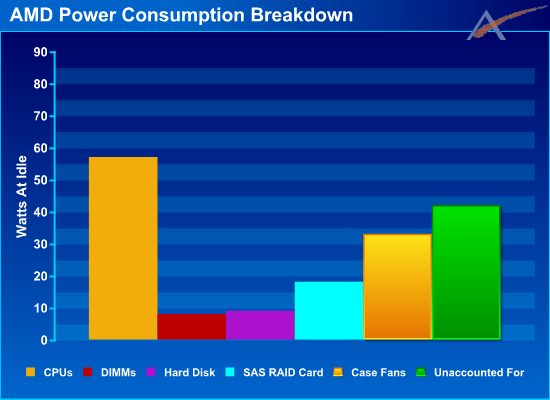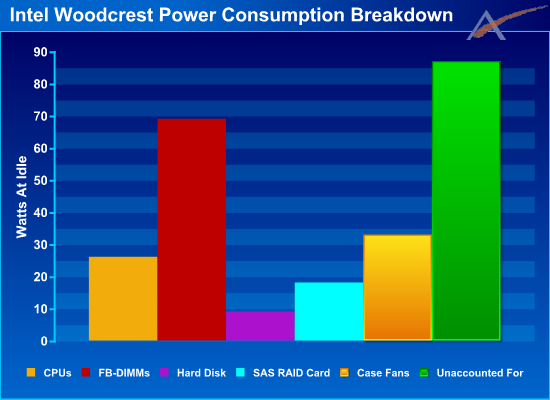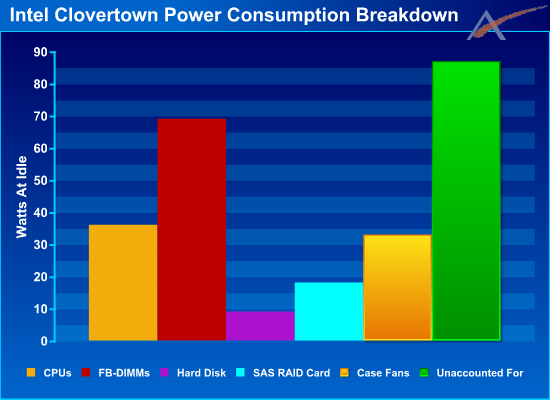Low Power Server CPU Redux: Quad-Core Comes to Play
by Jason Clark & Ross Whitehead on September 13, 2007 6:05 AM EST- Posted in
- IT Computing
Benchmarking Low Voltage
Since this article is focused on low power parts and that market is mostly focused on Performance/Watt, we decided we would only report results with all power management features enabled. To configure our servers with all power management features on, we perform the following:
On Intel
In the BIOS ensure that Thermal Management is On/Enabled, C1 Enhanced Mode is On/Enabled, and EIST Support is On/Enabled.
On AMD
In the BIOS ensure that PowerNow is On/Enabled. Additionally, you must install the Processor Driver, from AMD, in your OS.
For both platforms you must also set the Power Options in Control Panel to "Server Balanced Processor Power and Performance".
For details about the impact that the Power Management features had on a system at idle please see our previous article. With all Power Management features turned on we recorded idle power usage for all three systems.

We see that AMD has the lowest idle power consumption. Intel's Woodcrest system uses approximately 41% more power at idle, and the Clovertown system uses approximately 51% more power at idle. The Clovertown system only uses approximately 4% more power at idle than the Woodcrest system, which is not bad considering it has twice as many CPU cores.
During the testing, we often speculate about where all the power goes. We attempted to find out by measuring power consumption of the entire system at idle, then removing a component and re-measuring the power consumption. The difference in power can be attributed to the removed component. This is not a perfect way to determine component power requirements, but it does provide some general guidance as to where all of the power goes. The results are very interesting:

In the AMD system we see that the bulk of the power is consumed by the idle CPUs. Overlooking the "Unaccounted For", the next biggest consumer is the five case fans, followed by the SAS RAID Card. The "Unaccounted For" is everything which is not listed, including the inefficiency of the power supply and the motherboard and chipset.

In the Intel Woodcrest system we see that the CPUs require significantly less power than the AMD CPUs, 54% less to be exact. On the other hand the FB-DIMMs require 862% more power than the AMD DIMMs. (Yikes!) Also, the "Unaccounted For" is twice as high on the Intel system as the AMD system. Keep in mind both of these systems have identical power supplies, so the efficiency is roughly the same.

The Intel Clovertown system is identical to the Woodcrest system except for the CPUs, which require approximately 4% more power at idle.
Choosing the contenders
In previous articles, we've been asked to explain why we chose the parts we did for an article. For this article we used the latest low voltage quad-core parts from Intel and the latest low power dual-core parts from AMD. The first question that may come to mind is, "Why are you comparing a quad-core part with a dual-core part?". The answer is quite simple: for Intel the two quad-core / dual-core parts we're comparing cost about the same, so while the parts we are comparing aren't equal in terms of the number of Cores, they are equal in terms of price. On the AMD side of things, the CPU price is once again similar, but other than the just-released Barcelona there are no quad-core AMD offerings. Since testing for this article began over a month ago, including Barcelona wasn't an option at the time.
Since this article is focused on low power parts and that market is mostly focused on Performance/Watt, we decided we would only report results with all power management features enabled. To configure our servers with all power management features on, we perform the following:
On Intel
In the BIOS ensure that Thermal Management is On/Enabled, C1 Enhanced Mode is On/Enabled, and EIST Support is On/Enabled.
On AMD
In the BIOS ensure that PowerNow is On/Enabled. Additionally, you must install the Processor Driver, from AMD, in your OS.
For both platforms you must also set the Power Options in Control Panel to "Server Balanced Processor Power and Performance".
For details about the impact that the Power Management features had on a system at idle please see our previous article. With all Power Management features turned on we recorded idle power usage for all three systems.

We see that AMD has the lowest idle power consumption. Intel's Woodcrest system uses approximately 41% more power at idle, and the Clovertown system uses approximately 51% more power at idle. The Clovertown system only uses approximately 4% more power at idle than the Woodcrest system, which is not bad considering it has twice as many CPU cores.
During the testing, we often speculate about where all the power goes. We attempted to find out by measuring power consumption of the entire system at idle, then removing a component and re-measuring the power consumption. The difference in power can be attributed to the removed component. This is not a perfect way to determine component power requirements, but it does provide some general guidance as to where all of the power goes. The results are very interesting:

In the AMD system we see that the bulk of the power is consumed by the idle CPUs. Overlooking the "Unaccounted For", the next biggest consumer is the five case fans, followed by the SAS RAID Card. The "Unaccounted For" is everything which is not listed, including the inefficiency of the power supply and the motherboard and chipset.

In the Intel Woodcrest system we see that the CPUs require significantly less power than the AMD CPUs, 54% less to be exact. On the other hand the FB-DIMMs require 862% more power than the AMD DIMMs. (Yikes!) Also, the "Unaccounted For" is twice as high on the Intel system as the AMD system. Keep in mind both of these systems have identical power supplies, so the efficiency is roughly the same.

The Intel Clovertown system is identical to the Woodcrest system except for the CPUs, which require approximately 4% more power at idle.
Choosing the contenders
In previous articles, we've been asked to explain why we chose the parts we did for an article. For this article we used the latest low voltage quad-core parts from Intel and the latest low power dual-core parts from AMD. The first question that may come to mind is, "Why are you comparing a quad-core part with a dual-core part?". The answer is quite simple: for Intel the two quad-core / dual-core parts we're comparing cost about the same, so while the parts we are comparing aren't equal in terms of the number of Cores, they are equal in terms of price. On the AMD side of things, the CPU price is once again similar, but other than the just-released Barcelona there are no quad-core AMD offerings. Since testing for this article began over a month ago, including Barcelona wasn't an option at the time.










36 Comments
View All Comments
flyck - Friday, September 14, 2007 - link
why didn't you wait to revail this article when the tests were done on a barcelona system ?Now it is just comparing apples with oranges and thus making the conclusion obsolete.
Phynaz - Friday, September 14, 2007 - link
Since you can't buy a Barcelona based system at this point in time, this article is hardly "obsolete".JarredWalton - Friday, September 14, 2007 - link
You'll get Barcelona results for this sort of testing soon enough. The problem is, AnandTech isn't a single location; like many websites, we have people scattered around a large area. Johan and Christoph are even located in Europe, for example. So just because one of us has immediate access to certain hardware (i.e. the Barcelona launch CPUs) doesn't mean we all have access at the same time. Besides, the Barcelona launch articles literally had access to the CPUs for about four days before launch, and they were busy running other tests for the duration of that time.Justin Case - Saturday, September 15, 2007 - link
This article was published 3 days after Johan's Barcelona article.I suppose it's beyond Anandtech's technical ability to run the same benchmarks in the "european" and "american" systems, and compare the results? Maybe they wouldn't be valid due to the time zone or the metric system or something...?
Or maybe this article's "conclusions" had already been written, and doing a real quad vs. quad (instead of quad vs. dual) comparison would have spoiled things?
JarredWalton - Saturday, September 15, 2007 - link
As a matter of fact, yes, the article testing was indeed completed before Barcelona officially launched. The introduction and conclusion were edited to account for the fact that Barcelona is now officially launched (though not actually available for purchase anywhere). Will we test Barcelona performance/watt for a future article? Yes, and probably sooner rather than later. Does that make this article wrong? Nope. The conclusion is that a currently available quad-core Clovertown LV can beat a dual-core Opteron in some cases."In this article we see the tables turn somewhat. With two extra cores the Intel Clovertown parts are able to easily outpace the AMD Opteron, at least when overall load is near saturation. At low to average workloads, there is little difference between any of the parts, in which case server consolidation might be a better solution. Obviously, the quad-core parts are best suited for loaded database servers and their sweet spot is in virtualized environments." (Emphasis added.)
I'm not exactly sure what the problem is with that conclusion. Quad-core is better in heavy load environments, and having the ability to choose between quad and dual-core CPUs certainly can't be bad for companies. I guess you would rather have nothing than an article that examines one more facet of the performance spectrum? FB-DIMMs still use a lot of power, but it's nice to see that as the number of CPU cores ramps up, the overall penalty isn't quite as severe. How will Barcelona and Harpertown change the picture? We will have an article on that subject soon enough.
Proteusza - Sunday, September 16, 2007 - link
Then you should have pulled the article. It makes no sense now. "Quad core comes to play"?Intels quad core has been out for how long now? Quad core comes to play, in my mind, implies that either Intels quad cores are new, or that we have quad cores from both tested in this article.
Neither is true.
JarredWalton - Sunday, September 16, 2007 - link
Intel LV Quad-core is in fact brand new, however, and it's actually available for purchase right now. That is what this article is about, and the introduction makes it pretty clear. If the title makes some people click through to check out the article, and they end up disappointed that Barcelona isn't present, they can get over it. I'm sure when we post the Barcelona equivalent that it will have some equally catchy title to get people to give it a look.Perhaps by that point in time Barcelona procs will actually be available at major vendors. You can find prices for the Opteron 2350 at a lot of places, but every site that I've checked out is "temporarily backordered" or "out of stock". At $400-$500, the Opteron 2350 will certainly be an interesting alternative. Companies that have Socket F/1207 servers will definitely be interested. Of course, before they switch they'll want to test for at least a few weeks (or months) in a non-production environment. BIOS flashing on a server is not something IT departments like to do on a regular basis, and my bet is we will see several BIOS updates before the transition is done.
Proteusza - Monday, September 17, 2007 - link
Its LV quad core may be brand new, but quad core itself isnt.Quad core itself is a year old, or more, and your title implies otherwise to me.
JarredWalton - Monday, September 17, 2007 - link
"Low Power" is in the title... I'm not sure we can really do much more beyond changing the title to "Low Power Quad-Core Xeon without Barcelona"... but just wait a bit longer and then you can see other results for other CPUs.Justin Case - Monday, September 17, 2007 - link
So you're saying that this article was published now due to the release of new low-voltage Xeon models, and has absolutely nothing to do with the Barcelona launch?'mkay...
Following that line of thought, the article's title should have been "Quad-core Xeons: Low power models come to play". The "new" thing (and thus what now "comes to play") is the low voltage, not the fact they are quad-core.
It would still be odd (to say the least) that you didn't run a single benchmark on a Barcelona system, but at least the article's title wouldn't be so blatantly deceptive.